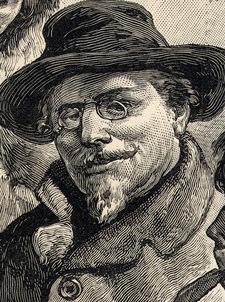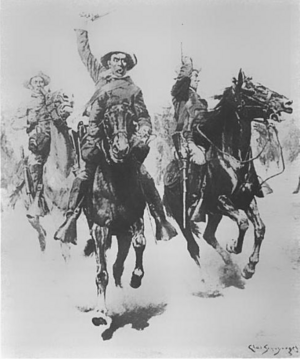Frederick Schwatka facts for kids
Quick facts for kids
Frederick Gustavus Schwatka
|
|
|---|---|

From an 1880 engraving
|
|
| Born | 29 September 1849 Galena, Illinois |
| Died | 2 November 1892 (aged 43) Portland, Oregon |
| Buried | |
| Allegiance | |
| Service/ |
United States Army |
| Years of service | 1871–1885 |
| Rank | |
| Unit | 3rd Cavalry Regiment |
| Battles/wars | Great Sioux War of 1876 |
| Other work | Arctic exploration |
Frederick Gustavus Schwatka (born September 29, 1849 – died November 2, 1892) was a brave American Army lieutenant. He was also a doctor and a lawyer! Schwatka became famous for exploring the cold lands of northern Canada and Alaska.
Contents
Frederick Schwatka's Early Life and Army Career
Frederick Schwatka was born in Galena, Illinois. His family moved to Salem, Oregon, when he was 10 years old. There, he worked as a printer's helper and went to Willamette University.
He later joined the United States Military Academy at West Point in 1867. He finished his studies in 1871. After graduating, he became a second lieutenant in the Third Cavalry. He served in the Dakota Territory.
Schwatka was very smart and studied many things at once. He became a lawyer in Nebraska in 1875. In the same year, he also earned a medical degree from Bellevue Medical College in New York. In 1876, Lieutenant Schwatka led the first cavalry charge at the Battle of Slim Buttes.
Searching for the Lost Franklin Expedition
In 1878, Schwatka led an important trip to the Canadian Arctic. The American Geographical Society asked him to search for clues about Franklin's lost expedition. This was a famous group of explorers who disappeared in the Arctic many years before. People hoped to find written records left by them.
Schwatka's team sailed to Hudson Bay on a ship called the Eothen. His group included William Henry Gilder, who was his second-in-command. They also had Heinrich Klutschak, a scientist and artist. An important member was Joe Ebierbing, an Inuit guide and interpreter. Joe had helped another explorer search for Franklin before.
The team landed on Depot Island in Hudson Bay on August 7, 1878. With help from other Inuit people, they traveled north. They used three sledges pulled by over forty dogs. They carried few supplies but had many weapons and ammunition.
They talked to Inuit people and visited places where Franklin's team might have been. They even found the skeleton of one of Franklin's lost crewmen. It was identified as Lieutenant John Irving.
Even though they did not find the papers they hoped for, Schwatka's trip was amazing. In 1880, he said his expedition made the "longest sledge journey ever." It lasted eleven months and four days and covered about 2,709 miles (4,360 km). It was also the first Arctic trip where the non-Inuit explorers ate the same food as the Inuit. This search happened in some of the coldest conditions ever known in polar exploration.
Later Explorations and Achievements
In 1883, the US Army sent Schwatka to explore the Yukon River. His group crossed the Chilkoot Pass. Then, they built rafts and floated down the Yukon River all the way to the Bering Sea. They named many places along the way. This raft journey was over 1,300 miles (2,092 km) long, making it the longest raft trip ever at that time.
After leaving the army in 1885, Schwatka led more expeditions. He explored Alaska two more times. He also went on three trips to northeastern Mexico. He wrote about the customs of the people and the plants and animals he saw in these regions.
Schwatka received special awards for his explorations. He got the Roquette Arctic Medal from the Geographical Society of Paris. He also received a medal from the Imperial Geographical Society of Russia. He was an honorary member of several other geographical societies around the world.
Books by Schwatka
Frederick Schwatka wrote several books about his adventures. These include Along Alaska's Great River (published in 1885). He also wrote The Search for Franklin (published in 1882). This book was later republished in 1965 as The Long Arctic Search.
Death
Frederick Schwatka died in Portland, Oregon, in 1892. He was 43 years old. He was buried in Salem, Oregon.
Schwatka's Legacy
Many places are named after Frederick Schwatka. Schwatka Lake in Whitehorse, Yukon, is one example. There is also Mount Schwatka in Alaska.
Since 1960, a boat called the MV Schwatka has carried passengers. It travels along the Yukon River through Miles Canyon to Schwatka Lake. In 2007, a special rifle was made to honor Frederick Schwatka. It shows scenes from his Arctic adventures.
Frederick Schwatka was also a member of the Scottish Rite Freemasonry. He joined the St. John's Lodge No. 37 in Yreka, California.
See also
 In Spanish: Frederick Schwatka para niños
In Spanish: Frederick Schwatka para niños


